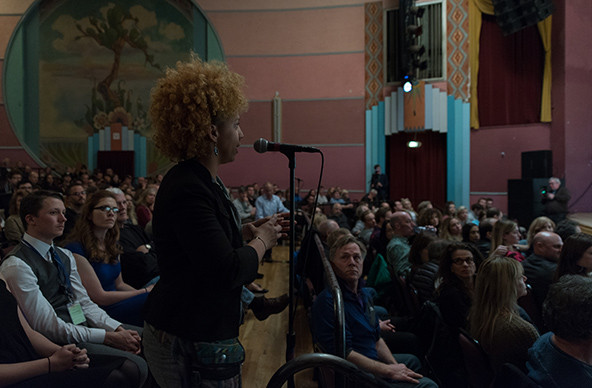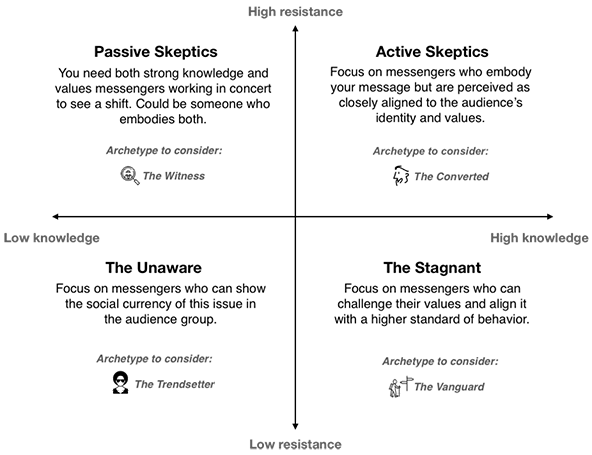 Who are you passing the mic to? Selecting the right messenger for your audience can be just as important as the message itself. (Photo by Caitlin Kleiboer/Courtesy of Exposure Labs)
Who are you passing the mic to? Selecting the right messenger for your audience can be just as important as the message itself. (Photo by Caitlin Kleiboer/Courtesy of Exposure Labs)
We’re living in an age of information confusion: Should we eat a plant-based diet? Does our vote really matter? Is social media a force for good? At a time when people find it increasingly hard to know which messages to trust, how do leaders of advocacy campaigns make their ideas stick?
It turns out a big part of breaking through is being intentional with who is sharing your message. If you are building campaigns day to day, you’re likely familiar with the term “trusted messenger.” Trusted messengers are people that community members regard as credible sources of information. But what makes them trusted? How do you know which messenger to partner with for your cause and your audience?
As part of this series on the science and practice of social impact campaigns, this article seeks to help readers better understand how to deploy an effective trusted messenger strategy in four different audience contexts. Drawing from our work in film-based advocacy across a range of social movements, we hope to leave you with actionable insights on how to collaborate with the right kind of messenger, and thus help your idea, innovation, or desired behavior take hold.
Eight Messengers to Transform the Message
There are three parts to effective communications: the message, the messenger, and the distribution. While we tend to focus most on crafting the perfect message or pushing it out widely, it’s easy to forget that the messenger, too, is critical to how audiences actually absorb that information. In fact, research tells us that we use trusted messengers as mental shortcuts to decide whether information is worthy of our trust and attention.
Are you enjoying this article? Read more like this, plus SSIR's full archive of content, when you subscribe.
Whether it’s working with social media influencers to promote flu shots in Black and Latinx communities, lifting up undocumented youth activists to reframe debates on immigration reform, or inspiring women to share their stories about sexual assault, the science is in: A message is only as effective as the person delivering it.
That said, not all messengers are equally effective in every context, so it’s helpful to start by recognizing different types. In practice, we’ve seen two primary ways that messengers shape the message: as knowledge transformers and as values transformers.
Messengers Who Transform Knowledge
In certain contexts, you may want to focus more heavily on transforming the perceived quality of the information you share. In your audience’s eyes, whose knowledge is most credible? “Knowledge transformers” are best suited for introducing ideas to communities in which there may be a lack of awareness or understanding. Here are three specific archetypes that may be helpful to consider:
 The expert: A trusted authority on the issue, usually through domain expertise or professional experience, such as a doctor or nurse sharing information about the COVID-19 vaccines.
The expert: A trusted authority on the issue, usually through domain expertise or professional experience, such as a doctor or nurse sharing information about the COVID-19 vaccines.
 The witness: A person with direct knowledge of or experience with the issue, such as a journalist covering state-sponsored violence against Rohingya Muslims in Myanmar. Assuming a certain level of risk in sharing what they witnessed can enhance their credibility, and thus their ability to transform knowledge.
The witness: A person with direct knowledge of or experience with the issue, such as a journalist covering state-sponsored violence against Rohingya Muslims in Myanmar. Assuming a certain level of risk in sharing what they witnessed can enhance their credibility, and thus their ability to transform knowledge.
 The affected: A person the issue has impacted the most, such as a Parkland high-school shooting survivor fighting for common-sense gun reform. They are especially potent messengers, in that their personal testimony can contribute to shaping both knowledge and values around your message.
The affected: A person the issue has impacted the most, such as a Parkland high-school shooting survivor fighting for common-sense gun reform. They are especially potent messengers, in that their personal testimony can contribute to shaping both knowledge and values around your message.
Messengers Who Transform Values
For many issues, particularly those that are politicized or strongly connected to people’s identities and values, messengers must be able to authentically connect a message to how a community sees itself. Just giving people information will not be enough to overcome motivated reasoning and the human tendency to seek out information that affirms existing beliefs. In these contexts, you need to focus on transforming the values associated with the ideas you’re amplifying. Who does your audience turn to for values affirmation and norm-setting within their social groups? Here are five “Values Transformer” archetypes that may be helpful to consider:
 The guide: a person who has embodied the core values of the target audience for decades, such as a retired US general urging people to wear face masks. They shape and defend the traditions of the target audience, allowing them to imbue your message with moral authority.
The guide: a person who has embodied the core values of the target audience for decades, such as a retired US general urging people to wear face masks. They shape and defend the traditions of the target audience, allowing them to imbue your message with moral authority.
 The converted: People who used to be skeptics and share similar values or characteristics as your target audience, but who had a personal experience that led them to change their beliefs. A former climate change skeptic and spokesperson that has changed his mind on climate is an example.
The converted: People who used to be skeptics and share similar values or characteristics as your target audience, but who had a personal experience that led them to change their beliefs. A former climate change skeptic and spokesperson that has changed his mind on climate is an example.
 The vanguard: Someone who represents the very leading edge of a movement, and by unabashedly walking the walk and challenging traditional systems of power, can move the center of a debate. Black feminist organizers on the frontlines of the Black Lives Matter movement are an example.
The vanguard: Someone who represents the very leading edge of a movement, and by unabashedly walking the walk and challenging traditional systems of power, can move the center of a debate. Black feminist organizers on the frontlines of the Black Lives Matter movement are an example.

 The trendsetter: Someone who is early to adopt and exhibit new ideas that align with their values and lifestyle, such as an Instagram influencer “sharing the mic” around racial equity. Their cultural cachet sets the standard for what is “cool” and can help mainstream new ideas within the target community.
The trendsetter: Someone who is early to adopt and exhibit new ideas that align with their values and lifestyle, such as an Instagram influencer “sharing the mic” around racial equity. Their cultural cachet sets the standard for what is “cool” and can help mainstream new ideas within the target community.
 The friend: A person who is a connector, who feels familiar to your audience, and who your audience naturally wants to spend time with. Affinity groups, hobbies, or passion areas may be places where these “friends” can engage your target audience on issues like preventing bullying in middle school.
The friend: A person who is a connector, who feels familiar to your audience, and who your audience naturally wants to spend time with. Affinity groups, hobbies, or passion areas may be places where these “friends” can engage your target audience on issues like preventing bullying in middle school.
Matching Messenger to the Audience Context
As we’ve just seen, there are many kinds of trusted messengers, but which should you partner with and when? The answer lies in understanding your audience. Recognizing that different people will require different communication strategies, start by asking two questions: How much does my audience already know and care about the issue, and how open or resistant are they to my message?
Developing effective messages and the right person to share them requires that you understand your audience, including how knowledgeable and receptive they are. (Note: The archetypes featured in this matrix are examples of who you might partner with, but not the only ones to consider.)
Scenario 1: Reaching ‘the Unaware’
If the audience you want to engage has little awareness of your issue and little innate resistance, you can immediately focus on making the message “sticky” and shareable. This lack of resistance is likely because the message or action you’re amplifying doesn’t require a significant shift of beliefs, personal investment, or risk. Your mission isn’t to change their minds, but to capture their attention and help them care about your cause.
Social norms stick when the audience perceives the behavior or opinion in question as something people like them are adopting. It’s important to get people in a shared network repeating that message often. This creates an environment around the person where they feel this is something “we care about.” Particularly effective are “the friend” and “the trendsetter” messengers, who can signal the social currency of your message.
Consider Girl Rising and the US girls’ education movement. Educating girls has one of the highest returns on investment in improving all kinds of development indicators, from health to poverty alleviation. Ten years ago, while there was little resistance to prioritizing girls’ education in international aid, awareness was low. Enter Girl Rising. Seeing the power of film as an organizing tool, the Girl Rising campaign released a feature film in 2013 featuring nine girls from around the world sharing their own stories. Each girl’s story was paired with a famous Hollywood actor to narrate. The film was then distributed through a network of local community organizers across the United States. This combination of “the affected” to transform the knowledge and “the trendsetter” to transform the information’s social currency created a powerful mix of messengers to help spread the word community by community.
Scenario 2: Activating ‘the Stagnant’
This audience is already aware of the issue and receptive to the message, so you need to partner with a messenger who can sustain their engagement and inspire action. In this context, many people already accept the big, foundational ideas behind your message, but they may have issue fatigue.
We know from science that people take action to remain in good standing in their social groups. They look to ingroup members they admire, observe and compare their behavior to them, and adjust their actions to maintain their own identity within the group. In this audience context, good messengers can challenge the status quo, energize the stagnant base, and shift the center of the debate. “The vanguard” messenger can be particularly effective here.
Take the film John Lewis: Good Trouble and the US voting rights movement. The 2013 US Supreme Court decision Shelby County v. Holder allowed the gutting of the Voting Rights Act (1965). This opened the floodgates to a new wave of voter suppression laws, threatening the ability of many Americans from poor, immigrant, indigenous, and minority communities to exercise their right to vote. In 2020, Participant and Magnolia Pictures released the documentary John Lewis: Good Trouble. The film featured the late US Congressman and civil rights hero John Lewis as its main subject, drawing a connection to modern-day voter suppression. To activate progressives in Georgia, an audience with some awareness and low resistance to the issue, a messenger combining “the vanguard” and “the guide” like John Lewis was a powerful way to convey the “protect the vote” message. The film’s impact campaign extended this strategy by creating short videos featuring “vanguard” activists like Latosha Brown of Black Voters Matter. Brown’s leadership mobilizing historically disenfranchised Black communities through music and inspiring community outreach embodied the spirit of the message: Let’s come together and make sure everyone can participate in the election.
Scenario 3: Breaking Through to ‘the Passive Skeptic’
This is an audience context where you need to prove your case, while also opening up people to information they may innately resist. The more unfamiliar or disruptive an innovation is, the greater the resistance typically is, which is why social change can be so difficult. Focusing on using messengers to transform the credibility and social legitimacy of the message is important.
Network science tells us that the more resistant people are to an idea or behavior, the more they need social reinforcement from their network to believe it’s okay for them to take action. Given low awareness and receptiveness, you need to transform both values and knowledge at the same time to see a shift. Effective messengers in this context include “the expert,” “the witness,” and “the friend.” Where possible, try to find a messenger who is both a knowledge and value transformer in one.
Here’s an example. Social media platforms like Google, Facebook, and Twitter have at one time or another espoused values of “do no harm” and “we connect the world.” However, despite emerging evidence from researchers and advocacy groups showing how these platforms spread hate and disinformation, most tech workers have clung tightly to the belief that they are pursuing a noble cause. To reach these passive skeptics, the Netflix film The Social Dilemma featured a chorus of “witnesses”—former tech executives blowing the whistle on their own products. By hearing directly from creators, the film was able to engage tech workers, sparking a wave of internal criticism and more public support on the need for reform. The executives had meaningful expertise, and those in the industry saw them as peers, making them ideal messengers to shift both knowledge and values around the issue.
Scenario 4: Converting ‘the Active Skeptic’
In this audience context, where you’re looking to overturn a strong belief or social norm that has already taken hold, you need to find messengers who can break through the resistance and encourage the audience to reexamine the issue with an open mind. Transforming the audience’s relationship to the issue and the value attached to the message is critical.
When the perceived costs of adopting the behavior are high, studies show that finding a messenger who is perceived as similar to the audience, by the audience, is important. Finding a messenger who is perceived to share their identity and values can help open the audience up to rethinking. We’ve found effective messengers in this context include “the converted” and “the guide.”
The impact of the film The Game Changers on the plant-based food movement is a good example. Mitigating climate change and improving health and athletic performance are just two of many good reasons to consider going vegan. Yet most people feel a strong cultural connection to eating meat. Men, in particular, often tie meat consumption to a sense of masculinity and strength. Shifting this belief system is a very difficult communications challenge.
The Netflix documentary The Game Changers has been effective at opening up space to challenge these beliefs. Despite deeply held resistance to going vegan among most male audiences, the movie features high-performance athletes (like strongman Patrik Baboumian and pro football player Derrick Morgan) who make the case. Regardless of how much stock people may put in the science, featuring athletes who have made the switch to a vegan diet has helped transform the perceived value of the information, creating space for audiences to rethink their positions. This messenger strategy centered on “the converted” has been so effective that even some of the most skeptical audiences have left ready to try a plant-based diet.
Conclusion
In today’s noisy information environment, making your ideas stick requires thinking carefully about not only what you need to say, but also who you need to say it.
Start by examining your audience’s level of awareness and resistance to your message or desired behavior. From there, take the time to build a nuanced understanding of which messengers—whether values transformers or knowledge transformers, or a combination of both—might work best for your audience. There’s no one-size-fits-all messenger strategy, but using these frameworks to choose the right one can help you strategically widen the range of possible voices to bring into the conversation and bring more specificity to your communications strategy.
Support SSIR’s coverage of cross-sector solutions to global challenges.
Help us further the reach of innovative ideas. Donate today.
Read more stories by Samantha Wright, Annie Neimand & Max Steinman.

